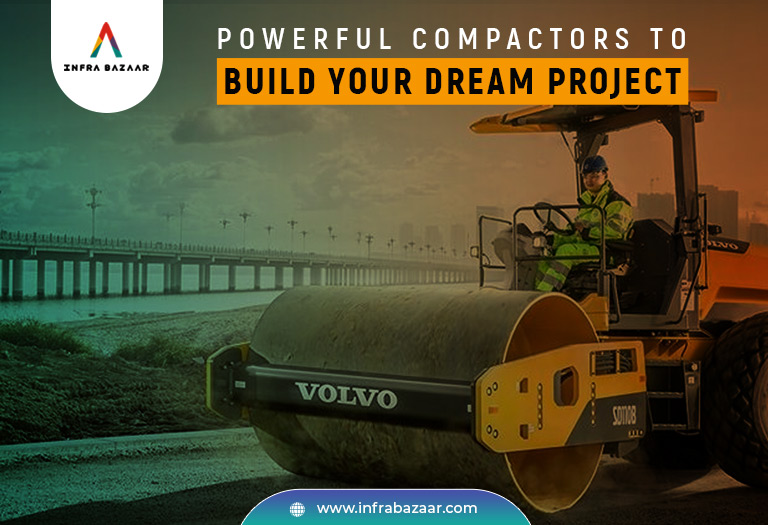
Posted By: Infra Bazaar
Compactors are key construction equipment used for land preparation by applying pressure on dirt, and soil to push the ground and fill air pockets. This is basically to pave the way to an even surface to allow stronger construction machines to work. Infrabazaar gives you a lowdown
Compaction on soil can either be a static or vibratory force. Static compression uses machines' weight for flattening the earth and vibratory. as the name suggests. passes vibrations to the surface for soil compression.
Compactor equipment has three major types basis the surface area to be covered and the force to be applied - Rammers, Plates and Rollers. While rammers and plates apply less pressure on smaller areas, rollers tend to have wider coverage with more pressure.
Here are the top compactor types and their usages:
1. Power Rammer:
Power Rammers also known as Trench Rammers are compact versions of rammers used in smaller areas like ditches and confined spaces. They primarily use static force to apply pressure.
2. Vibratory Tamper:
These are plate compactors which have a flat base design at the bottom and use vibrations to prepare the soil. They are also very compact versions and are used best for confined spaces.
3. Vibrating Plate Compactors:
Vibrating Plate Compactors are bigger versions of plate compactors with larger plates to produce a larger impact with respect to force and area. They also come in different sizes and vary from 100 to 300 pounds in weight. They can produce 10000 vibrations per minute and can compress clay and sand as well.
4. Self-Propelled Roller:
These are also called pedestrian, hand-guided compaction devices with a drum coverage of 2 feet. They are smaller rollers which require less energy and power.
5. Single Drum Vibratory Rollers:
Single drum vibratory rollers as the name suggests have a single drum in front, which allows one to move over surfaces quickly for soil compaction. This looks more like a small vehicle where the back has a pair of ties to balance the roller in front. These are comparatively stronger compaction tools however one needs to compress the surface a few times before the work tests are done.
6. Large Dual Vibrating Drum Roller:
Dual vibrating drum rollers, also known as tandem rollers, are just a bigger version of the single drum rollers. They come with an additional drum at the back as well instead of the tires in this case. The extra drum in the back helps create the impact in compaction with fewer rounds.
7. Smooth Wheel Rollers:
Smooth wheel rollers are actually more suited for compacting
because of the way they are designed. That's why you will see them on highways as well. The drum rollers hence tend to be used for soil preparation.
8. Static Roller:
These rollers tend to pass static compression to the ground and have 2-3 drums which function as wheels. The static pressure ends up smoothening rough surfaces and because there is no vibration the soil doesn’t get compressed further. Static rollers really work well on poorly graded surfaces and light particle material surfaces as the impact remains on the evening the surface is out.
9. Multi-Tire Pneumatic Roller:
These rollers have multiple tires on two axles in the front and back of the vehicle. These work well on thin soil particles and have a larger impact range, hence saving soil from collapsing. They also tend to bring the finer particles up in an asphalt mix with their impact.
10. Heavy Pneumatic Roller
Heavy pneumatic rollers tend to be the heavier formats of the typical multi-tire pneumatic rollers. They can be operated on fine silts and gravel and can compress deeper layers of soil.
11. Sheepsfoot Roller:
A sheepsfoot roller has a steel drum with rectangular steel protrusions, called lugs which extend from the drum’s surface. These work well on fine-grained soils and clay. Sheepsfoot rollers on embankments, pavements, dams and railroad projects.
12. Elephantsfoot Roller:
Elephantsfoot rollers are another version of sheepsfoot rollers. Their drums have fewer lugs, with a wide, flat plate welded onto the remaining surface. This design helps them to work on soils with less cohesion.
13. Padfoot Roller:
Padfoot rollers also called slash presser rollers, feature lugs on their drums similar to elephant foot rollers. Their lugs are much larger and they can break soil clusters easily.
14. Grid Roller:
The grid roller as the name suggests has interconnected steel bars which resemble a steel grid. They break down large rocks and also compress the soil. These remain high impact and are generally attached to a vehicle to operate.
15. Track Rollers:
Track rollers have a drum in front but have continuous tracks in the back. These provide a smoother finish to soil and end up giving a very reliable compression to the ground.
Equipment tends to cut a deeper hole than anticipated, in your pocket despite being a necessity and hence it is very important to understand the scope of your project, costs, work involved in compaction, kind and the extent of surface preparation to really understand the kind of equipment needed.
#Compactors #ConstructionEquipment #SoilCompaction #Rammers #Plates #Rollers #PowerRammer #VibratoryTamper #VibratingPlateCompactors #SelfPropelledRoller #SingleDrumVibratoryRollers #LargeDualVibratingDrumRoller #SmoothWheelRollers #StaticRoller #MultiTirePneumaticRoller #HeavyPneumaticRoller #SheepsfootRoller #ElephantsfootRoller #PadfootRoller #GridRoller #TrackRollers #LandPreparation #ConstructionMachines